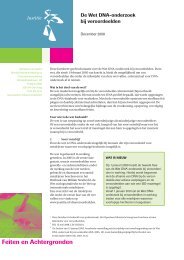INTERPOL HANDBOOK ON DNA DATA EXCHANGE AND PRACTICE
INTERPOL HANDBOOK ON DNA DATA EXCHANGE AND PRACTICE
INTERPOL HANDBOOK ON DNA DATA EXCHANGE AND PRACTICE
You also want an ePaper? Increase the reach of your titles
YUMPU automatically turns print PDFs into web optimized ePapers that Google loves.
APPENDIX 7recommendationsfrom the enfsi working groupList of the recommendations from the document as per April 2008:1. Every EU/ENFSI-country should establish a forensic <strong>DNA</strong>-database and specificlegislation for its implementation and management.2. The type of crime-related stain <strong>DNA</strong>-profiles which can be included in a <strong>DNA</strong>databaseshould not be restricted.3. To increase the chance of a <strong>DNA</strong>-profile of a stain to match to a person, the numberof persons which are likely to cause matches in a <strong>DNA</strong>-database should be as high aslegally (and financially) possible.4. Managers of national <strong>DNA</strong>-databases should establish (together with otherstakeholders) criteria for the inclusion of partial <strong>DNA</strong>-profiles to obtain an acceptablebalance between the minimum allowable level of evidential value (match probability) ofa <strong>DNA</strong>-profile and maximum number of adventitious matches a partial <strong>DNA</strong>-profileis expected to generate.5. <strong>DNA</strong>-profiles produced by older commercial kits should be upgraded (if possible)after a match in the national <strong>DNA</strong>-database to increase the evidential value of thematch and also to fulfil the criteria for international comparison if a country wantsto include <strong>DNA</strong>-profiles produced by older commercial kits in international searchactions.6. The number of loci in reference samples should be the maximum of the numberof loci present in the kit(s) used for the production of the <strong>DNA</strong>-profiles of thereference samples to enhance the chance of finding relevant matches with partial<strong>DNA</strong>-profiles.7. Labs producing <strong>DNA</strong>-profiles for a <strong>DNA</strong>-database should, as a minimum, be ISO-17025 (and/or equivalently nationally) accredited and should participate in challengingproficiency tests (for Europe: GE<strong>DNA</strong>P).8. When low copy number <strong>DNA</strong>-profiles are included in a <strong>DNA</strong>-database a dedicated(near) match strategy should be used for them.9. When a new allele is observed in a <strong>DNA</strong>-profile, its presence should be confirmedby repeated <strong>DNA</strong>-isolation, PCR, Capillary Electrophoresis and allele calling of the<strong>DNA</strong>-profile.PAGE 100 APPENDIX 7recommendations from the enfsi working group







